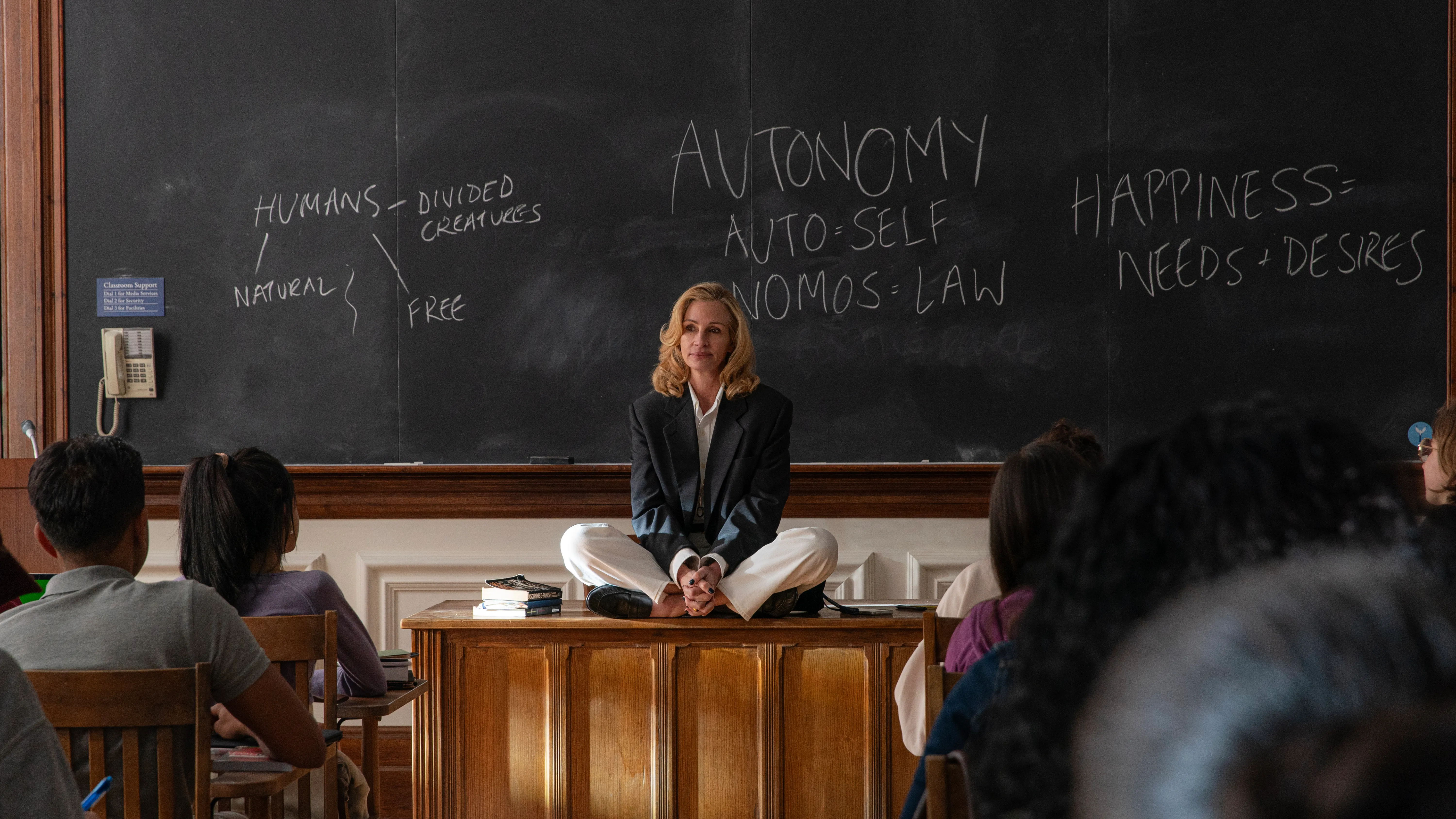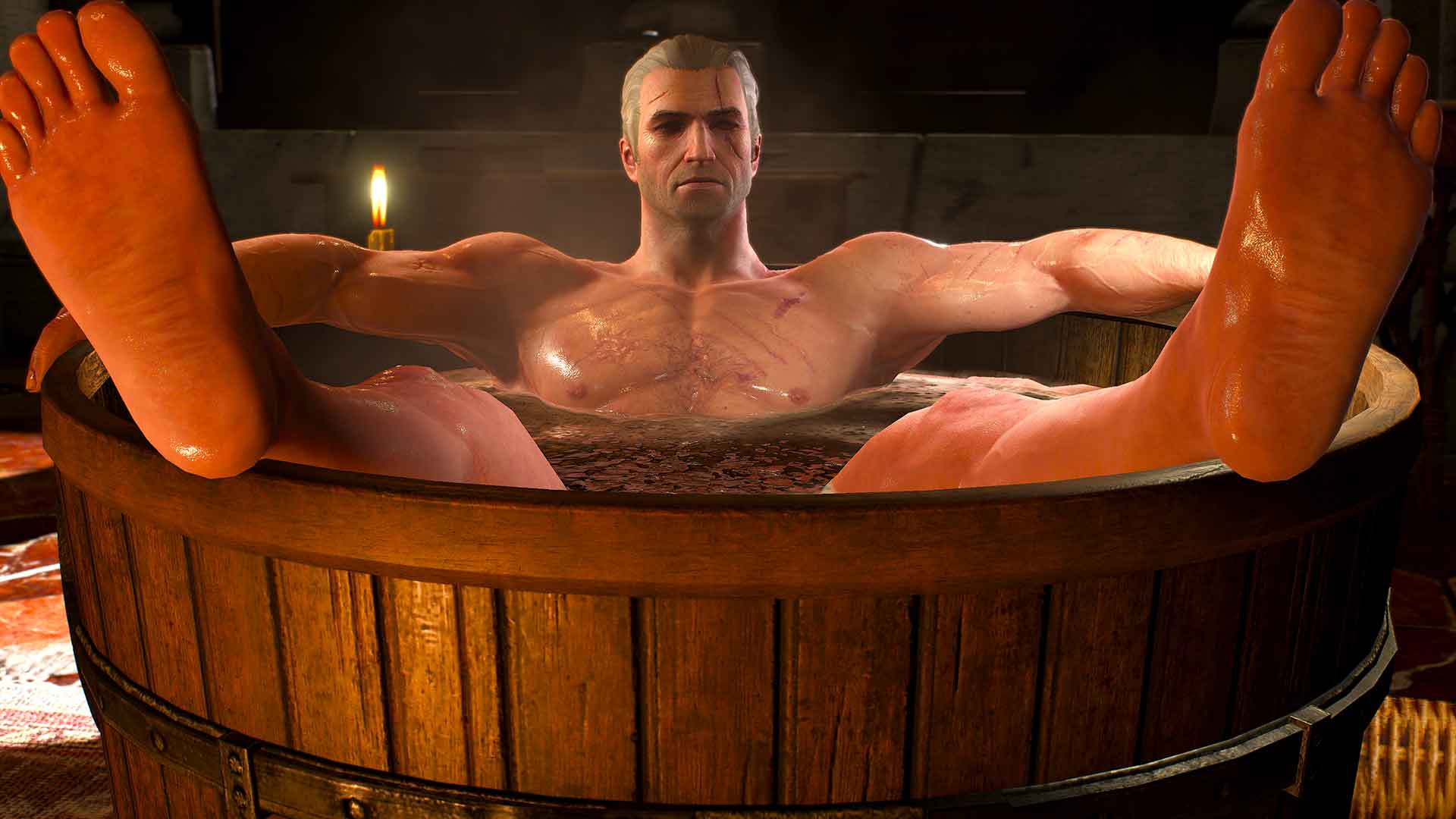Copyright gq

The story contains some spoilers for After the Hunt. A pivotal dinner party in After the Hunt, Luca Guadagnino’s post-#MeToo thriller that takes place at Yale University, depicts the sort of scene one might expect from a gathering of Yalies: lively debates, endless bottles of wine, and blazers galore. As is the case with many such Ivy League soirées, everyone in the room is angling for something, and they’ve all dressed accordingly. Alma Imhoff (Julia Roberts), a beloved professor of philosophy, is hosting the party in a sleek white suit with no shirt underneath. (Brave, considering the glass of red wine in her hands.) Per the film’s costume designer Giulia Piersanti—whose primary gig is as Celine’s head of knitwear—the character “has this allure about her that’s very confident, and I thought clean lines. I wanted her to be uplifted, elegant, but not too feminine.” Fredrick Imhoff, Alma’s psychiatrist husband, played by Michael Stuhlbarg, often putters about in his Japanese suits—just as chic as Alma’s, but more understated. Elsewhere at the dinner are the Imhoffs’ university friends and colleagues, Dr. Kim Sayers (Chloë Sevigny) and Hank Gibson (Andrew Garfield), who are loosely adhering to the informal dress code in blazers thrown on over unbuttoned dress shirts. Hank, a young, flirtatious adjunct professor, is more intentional about this semi-subversion of the Yale sartorial norm. He lounges in a Canadian tuxedo with his feet on the couch, prioritizing comfort over the social etiquette of coastal elites he did not grow up around. Also present is Margaret “Maggie” Resnick (Ayo Edebiri), Alma’s protege, whose style in the film oscillates between channeling an innocent schoolgirl and a cunning working woman. She’s the only student in a full suit and dress shirt buttoned to the top, like Frederick, and her modesty contrasts with Alma’s plunging suit. “It is somehow as if [Maggie] were guessing what Alma would be wearing,” Piersanti explains. (Another parallel between the two is that both Alma and Maggie wear dark nail polish throughout the film.) As the psychosexual cat-and-mouse game at dinner—and in the rest of the film—unfolds, the characters’ (oftentimes menswear-adjacent) ensembles tell the viewer who’s in power—and who’s gaining or losing steam. Below, the film’s costume designer tells GQ about the nitty-gritty behind Alma and Maggie’s power suits, her love of American “everything goes” style, and her longstanding partnership with Luca Guadagnino. GQ: You and Luca have worked on several projects together, including Call Me By Your Name and Bones and All. How did you two meet? Giulia Piersanti: We met many years ago at a dinner party, when we were younger. He was a young director at the time who’d done just one film, and a friend of mine mentioned to me that he had seen the work of this really cool young director. And then, by coincidence, we were at a dinner party once and he said, “Oh, that’s the director I was talking to you about.” We started to chat and we became really close friends right away, and have been so for many years. After he did I Am Love, he called me and asked me if I wanted to do costumes for A Bigger Splash. He wanted a different perspective from a classic costume designer, I guess. In a New York Times interview, you said that to prepare for Call Me by Your Name, you and Luca went door to door in Crema collecting photographs of locals from the ’80s. What was your research process for After the Hunt? The characters are based on what Luca tells me about them from the script, but also he’ll talk me through what he wants to say and what the intent is for each character. And then I go from there. The character of Alma, I was really looking at a certain type of timeless elegance. Elegance doesn’t mean dressed up, necessarily. There are no heels; there are no dresses in the film. It’s more about the allure of some women that I admire in style, and what it is about them that makes them like that. I was trying to do that on Alma’s character because she’s a worldly, intellectual woman—a smart woman, a strong woman. She’s working in a man’s world, and she’s practical at the same time. No fussy, trendy. The research for the students and the general campus was quite real research. We had a person go on campuses and take pictures, and that was very helpful. Who were some of the women you admire that you thought of for Alma? There’s definitely Julia Roberts [herself] in there, let’s not forget. She was in the mood boards with her gorgeous suits from the ’90s and early 2000s. But there are also women like Carolyn Bessette, Joan Didion, Tina Chow, and even Camilla Nickerson—all these women were in my references. There was also a lot of working women: working women at home and working women in the streets. Alma’s character wears a lot of white. What was that inspiration from? Before we film, we do camera tests, and Malik’s [cinematographer Malik Hassan Sayeed] photography was very light-absorbing. It’s very important to test fabrics—how they absorb the light and how they reflect light, and what the colors look like once they are with the photography, which can be very different from a fitting room. So white was a choice, specifically in the dinner scene. The light in the living room of the dinner scene is very low and very absorbing, and it absorbed a lot of the colors that we had. We see a montage of her in her daily life, but it’s the first scene that we really see her with her surroundings, with the people that she mesmerizes, and she’s very attractive to the people around her. She has this allure about her that’s very confident, and I thought clean lines, a white suit was just the perfect choice. I didn’t want to put her in a dress, I didn’t want to put her in heels. It was a home dinner, but still I wanted her to be quite uplifted, elegant, but not too feminine either. So there’s no shirt, there’s just a white suit, a bracelet, and a couple of rings, and that’s it. I wanted it to be very clean and very focused. Did any of the actors take any of the wardrobe home that you know of? Yeah, I think Julia Roberts did. Yes, I think she did. I think she has a right to take whatever she wants, actually. [Laughs] I don’t know if the other actors can, but yeah, I think she took things, for sure. Do you know what she took? Was it the white suits? I remember for sure a Hermès scarf. I found it so interesting that Maggie Price, Ayo’s character, starts dressing like Alma as the film goes on. During the first dinner scene, Maggie is wearing a very Whoopi Goldberg-like suit. What were some of the mood boards for Maggie? The idea in the script does say that she emulates and copies Alma. So once I had it clear in my head what I wanted for Alma’s wardrobe, I started to look into buying similar things for Maggie, just with a different age target—younger. The difference is that Alma is very sure of herself in her kind of suit, and Maggie is just emulating her, somehow, and she’s wearing a more masculine look with a shirt. Through the film, she’s trying to replicate some of her looks in her own way, except for the last scene. I wanted to talk about the last scene. She had on so much color. Basically, for the whole film, I was very focused—I used very few wardrobe pieces, and they were repeated through the different characters. So there’s always blazers, there’s always button-downs, loafers, jeans. It differs very little from that. And it was a specific choice. I didn’t have dresses, I didn’t have sweaters; no soft lines, no “sweet,” no trendy. I wanted the last scene to have a real contrast. It’s a few years later, but I also really wanted to show that Maggie had broken away from Alma’s spell, and she was coming into her own. We don’t know if she’s coming into her own or if she’s imitating someone else in her present life. But in any case, it really needed to be a big difference. So she’s wearing everything I said that I would not put in the rest of the film. So she’s wearing a dress, it’s printed, she’s wearing jewelry, feminine hair, and she looks beautiful. She always looks beautiful. It’s interesting that you mentioned jeans, because Andrew Garfield’s character wears denim on denim. He’s literally wearing a shirt with a blue collar, but he’s trying to emulate this New England style, but can’t really get there fully. He’s a young Harrison Ford: sexy, scruffy. He’s quite different from the other characters. He’s someone I imagine coming to where he is thanks to his good looks, and he knows it. I wanted to have this kind of confidence in him. That’s a similar confidence to Alma, but it’s just a completely different style. He comes from a different background from Alma and her husband, and that’s quite obvious in the wardrobe, but he also has that kind of “I’m too sexy to try” type of thing. Even at dinner, he’ll wear the same thing he’s wearing during every other scene, but he just has a blazer on top of it, and his feet up on the couch. Yeah, everything’s very loose and very lived in. Yeah, exactly. He definitely wears the most worn-out pieces and vintage, and there’s a vintage Ralph Lauren in there and stuff like that. I can’t remember if he’s the only character who wears jeans in the film. Is he? Everybody’s wearing jeans! Alma wears white jeans, but she also wears blue jeans. Frederick [Michael Stuhlbarg], Julia Roberts’ husband, is the only one who is always in suits, Japanese suits. He’s always wearing these Japanese brands that I really like for menswear, like Comoli. His shirts are from Comme des Garçons, and the inspiration behind them was like Philip Glass and David Lynch and how they wear these button-up shirts with no ties, but the suits all have these beautiful Japanese fabrics from Japanese brands, which have a really nice look within the photography, and how they reflect and absorb light. He’s a cozy character. Everyone else is quite constrained. I love to see Michael Stuhlbarg in anything. You worked with him on Call Me By Your Name. Many times I worked with him, even on Bones and All. In Bones and All, he’s like, shirtless with overalls, and drunk and dirty in mud, and then Call Me by Your Name, he’s this very European dad. I’m sure that in Call Me By Your Name, there’s a lot of my own dad’s references in there, polo shirts and khakis and things. He’s very different here, and I love the idea of working with the same actors more than once, and I feel like playing dress up with them. It’s funny. I’ve worked with Michael three times. I worked with Chloë Sevigny three times, with Timothée [Chalamet] three times, and every time they look so different, and I get a kick out of seeing them in such different looks and how they can be changed into a character. Chloë, it took me a while to realize that that character was her because she looks so different. The characters all have very East-Coast-academic elements to their wardrobes. But they’re styled all very differently, and Alma has her confident allure, her chicness; Maggie’s youthful, boyish look. Kim, which is Chloë’s character was less refined, basically. So the shirt is too open, the jewelry is just a bit too much. he’s not goofy, but just a bit unproportioned in her clothing and not necessarily put together as nicely as Alma would be. When she’s not trying to dress like Alma, Maggie wears a lot of “schoolgirl” looks. There’s the scene where she’s wearing boxers and a sweater vest. Were you aiming for more of a traditional preppy look? Yes, yes. Maggie’s for sure preppy. I wanted a lot of dorm looks for her. The boxers—girls wear boxers, of course, with the vest outside and stuff, and there are definitely trends that I was looking at, but it’s always navy and pinstripe. I really liked the Yale dad sweater that she had. They’re so hard to find. I was very lucky. I was really looking specifically for funny Yale things that students wear. I feel like there’s a resurgence of prep, at least in America. What do you make of that resurgence? What do you think is the appeal? There are a lot of brands that replicate that kind of preppy American look in Europe. There’s a certain chicness to it, for sure. Europeans are also attracted to Americans and what American fashion is, especially teenagers and younger generations. It’s so blended in now, but I would say that it’s young and cute and quite chic in its own different kind of way. I think East Coast fashion is quite Europeanized. There’s a softer line between them rather than in other cities or other areas of America. Yeah, even with the name New England, there’s that blend there. Are there any trends among college students that you, throughout your research, really loved and some that you really hate that you’ve seen? I really do like boxers worn outside with loafers, a baseball cap, and just a white T-shirt. I just find that super cute. Some of my assistants at the office wear that. I’m a big fanatic of denim. I just like young people and students. I find that so appealing to me. What are the specific signifiers if you were to see someone in any place in the world that you would be like, “This person is American”? Yoga clothes. There’s definitely this thing about sportswear and yoga attire that is totally culturally accepted in America [but] in Europe is less common to see. I like it; I find it interesting how people are okay with feeling quite comfortable in their clothes, their day clothes. I really like American fashion, and I like the freedom that Americans have in their way of dressing. I grew up in LA [with]“everything goes” style. Kids in America, they’re dressed like fairies to go to school, or pajama bottoms and fairy wings, and that’s totally fine. I wished that for my kid, but it wasn’t the case. He went to a European Italian school. But yeah, the freedom and the mix-and-match that Americans have that we are missing in Europe is something that I enjoy about American fashion a lot.



